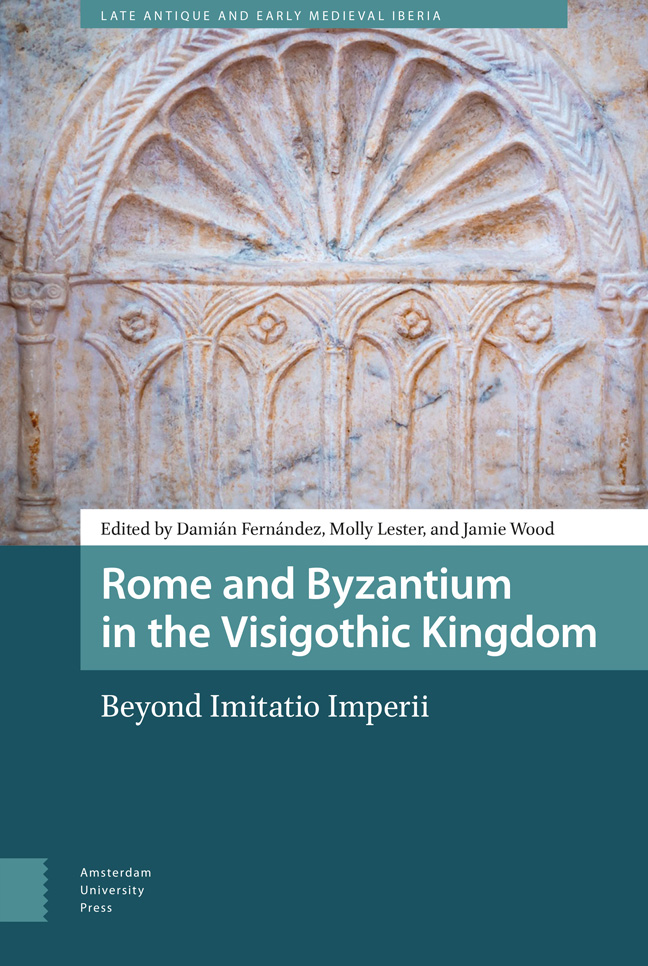Book contents
- Frontmatter
- Contents
- List of Figures and Tables
- Abbreviations
- Acknowledgements
- Maps
- Introduction
- 1 Visigothic Spain and Byzantium: The Story of a Special (Historiographical) Relationship
- 2 The Development of the Visigothic Court in the Hagiography of the Fifth and Sixth Centuries
- 3 Experiments in Visigothic Rulership: Minting and Monetary Reforms under Alaric II
- 4 A Comparison of Roman and Visigothic Approaches to Exile
- 5 The Roman Jewel in the Visigothic Crown: A Reassessment of the Royal Votive Crowns of the Guarrazar Treasure
- 6 Capitalhood in the Visigothic Kingdom
- 7 Making Rite Choices: Roman and Eastern Liturgies in Early Medieval Iberia
- 8 Ethnicity and Imitatio in Isidore of Seville
- 9 Re-imagining Roman Persecution in the Visigothic Passions
- 10 Romanness in Visigothic Hagiography
- 11 Empire and the Politics of Faction: Mérida and Toledo Revisited
- 12 The Agents and Mechanics of Connectivity: The Mediterranean World and the Cities of the Guadiana Valley in the Sixth Century
- 13 Staying Roman after 711?
- Index
1 - Visigothic Spain and Byzantium: The Story of a Special (Historiographical) Relationship
Published online by Cambridge University Press: 20 February 2024
- Frontmatter
- Contents
- List of Figures and Tables
- Abbreviations
- Acknowledgements
- Maps
- Introduction
- 1 Visigothic Spain and Byzantium: The Story of a Special (Historiographical) Relationship
- 2 The Development of the Visigothic Court in the Hagiography of the Fifth and Sixth Centuries
- 3 Experiments in Visigothic Rulership: Minting and Monetary Reforms under Alaric II
- 4 A Comparison of Roman and Visigothic Approaches to Exile
- 5 The Roman Jewel in the Visigothic Crown: A Reassessment of the Royal Votive Crowns of the Guarrazar Treasure
- 6 Capitalhood in the Visigothic Kingdom
- 7 Making Rite Choices: Roman and Eastern Liturgies in Early Medieval Iberia
- 8 Ethnicity and Imitatio in Isidore of Seville
- 9 Re-imagining Roman Persecution in the Visigothic Passions
- 10 Romanness in Visigothic Hagiography
- 11 Empire and the Politics of Faction: Mérida and Toledo Revisited
- 12 The Agents and Mechanics of Connectivity: The Mediterranean World and the Cities of the Guadiana Valley in the Sixth Century
- 13 Staying Roman after 711?
- Index
Summary
Abstract
Most late twentieth-century studies dealing with the Visigothic kingdom of Toledo mentioned its alleged imitation of Byzantium as its hallmark, singling it out from the rest of barbarian Europe. This was not a general imitatio imperii, but an imitation of the only Roman empire contemporary to the Gothic polity: eastern, Greek-speaking, exotic Byzantium. This chapter discusses the origins of Byzantinism in Visigothic historiography, its occasionally scant grounding in the evidence, and the ideological functions it fulfilled for historians. In the twentieth century, the Byzantinist paradigm produced well-arranged yet often contradictory narratives of one of the longest-lived post-Roman kingdoms in the West. Only lately has political and scientific globalization dispelled both the illusion of the uniqueness of Spanish features and the necessity for grounding it in Byzantinism.
Keywords: historiography; Byzantium; late antique archaeology; ritual; Mediterranean; Germanism; Romanism; National Catholicism; Marxism
In one of his last articles, the late Gilbert Dagron pointed out how Byzantium was purposely ‘forgotten’ in historiographical constructions of Europe stretching back to the First World War and continuing through the Annales school. The racist myth that Europe was produced by a merger between an exhausted Romanity and a young and vital Germanity was then replaced by the idea that Europe had emerged out of the mosaic of peoples in Charlemagne's empire. Significantly, in this new narrative, Charlemagne's Europe had moved to the north, away from the Mediterranean area, and Byzantium had no further role in European memory. This historiographical perspective left aside not only Mediterranean Byzantium, but also the Iberian peninsula, which had entered the European community fairly late, just as, centuries before, it stood on the margins of the Carolingian sphere of influence. It should hardly be surprising that, whereas the rest of Europe built a collective memory by deliberately forgetting Byzantium and the Mediterranean, Spain used Byzantium to work out parts of its own memory.
Still, such diverging paths do not account enough for the fact that, for several decades, many historians of the Visigothic kingdom were seemingly so fascinated by the Byzantine empire that they strove to uncover similarities between both polities, or even the imitation of the latter by the former—an obsession we will call ‘Byzantinism’.
- Type
- Chapter
- Information
- Rome and Byzantium in the Visigothic KingdomBeyond Imitatio Imperii, pp. 29 - 52Publisher: Amsterdam University PressPrint publication year: 2023



